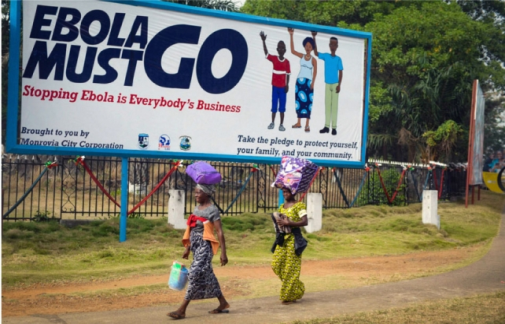Fostering Behavior Change During Disease Outbreaks: Insights from Ebola Response in Africa
The COVID-19 pandemic has prompted governments worldwide to seek to change behaviors on a mass scale to stem new infections. (Click here for CRS resources on COVID-19.) The challenges and successes of analogous efforts during the two largest Ebola outbreaks to date—in West Africa (2014-2016), and in eastern Democratic Republic of Congo (DRC), starting in 2018 and now seemingly waning—may offer lessons for current efforts to contain COVID-19, even though the two viruses differ in significant ways.
Dubbed by some a "disease of social intimacy," Ebola is transmitted through direct contact with the bodily fluids of an infected individual. Highly personal interactions, such as caring for infected family members and burying the dead, can spark chains of infections. In both Ebola outbreaks, authorities sought to convince or compel local populations to stop touching while exchanging greetings, avoid gathering in groups, isolate sick family members in specialized care centers, and starkly alter funeral rites.
Distrust of health workers, hostility toward government officials, misinformation, and inadequate communication and transparency between responders and affected communities hindered containment efforts during both outbreaks. Local resistance to infection control measures regularly disrupted the response and sometimes turned violent. Behavior changes nevertheless ultimately helped contain Ebola in West Africa and DRC. In Liberia, researchers found that "behavioral change resulting from a successful social mobilization campaign may have averted hundreds, if not thousands" of deaths in one hard-hit county.
As discussed below, successful behavioral change campaigns sought to understand the perceptions and practical needs of affected communities, ensured that communications were accurate and culturally appropriate, and recruited (and in many cases, paid) community members to spearhead local initiatives. In contrast, efforts to use force to effect behavior changes often backfired. Increasing the transparency of health responses—for example, enabling family members to communicate with loved ones undergoing treatment—may also have helped build trust in both West Africa and DRC. The U.S. Agency for International Development (USAID), which provided hundreds of millions of dollars toward Ebola response efforts in West Africa and DRC, supported peaceful community outreach and health communications campaigns through a number of programs.
|
Figure 1. Example of Ebola Messaging in Liberia |
 |
|
Source: U.N. Mission in Liberia |
Involving community members in communication and response activities was crucial. Studies suggest that behavior change efforts were more effective when they accounted for local perceptions of the disease. Incorporating community feedback on messaging helped combat misinformation and rumors. Successful campaigns worked with local leaders and healthcare workers to craft and refine messages regarding infection control measures, which were then broadcast on the radio in local languages—and sometimes via songs recorded by regional pop stars.
Effective campaigns mobilized networks of local residents—capable of understanding and overcoming suspicion—to convey information in context-appropriate ways. Engagement with community leaders and traditional healers was important for ensuring compliance with physical distancing measures such as case isolation and quarantine. Community members were also recruited to serve in teams carrying out "safe and dignified burials." In addition to expanding response efforts, tapping into community networks helped sidestep or overcome a lack of faith in government actors.
In one study, community responders—who often faced great personal risk of infection and/or violent backlash—cited feelings of "patriotic duty" and "moral responsibility" as their top motivations. At the height of the West Africa outbreak, donors also funded cash salary and indemnity payments for responders. Management and coordination of the Ebola workforce (including community volunteers as well as health workers) varied across affected countries, but such initiatives broadly sought to ensure that local responders were paid directly and on time, often using mobile money transfers.
Effective behavior changes were sensitive to local norms and practical needs. Studies indicate that critical behavioral shifts took hold only when public health messaging considered local cultures. Burials, which carry important cultural weight and can be vectors of Ebola transmission, were one example. In both West Africa and DRC, practices that health authorities initially urged (which did not allow family members to view the body, choose the location, or play any role in the funeral service) provoked backlash and resistance. Ultimately, burials that allowed for safe community participation and religious observance were more widely accepted and helped stem infections. Along with community members, a network of anthropologists also disseminated information on cultural sensitivities and best practices to responders.
Observers also stressed the importance of aligning health communications with practical needs. Focus groups in Liberia indicated that they were inundated with basic information about Ebola, but received little guidance, for instance, on how to manage a family during quarantine or respond to a potential case prior to the arrival of health teams.
Heavy-handed security efforts often backfired. At the height of the Ebola outbreaks in Liberia (2014) and DRC (2019), security force actions reportedly spurred resistance to behavior changes and sparked violence. When soldiers and police tried to enforce a mass quarantine by forcibly sealing off a large slum in Liberia, residents rioted. Discussions with community leaders, police patrols, and the provision of food and other supplies eased tensions.
In DRC, a practice of stationing armed personnel at health facilities caused fear and thus "made it more challenging to stop the outbreak," while also dissuading people from seeking other health care, according to Doctors without Borders. In extreme cases, police and soldiers reportedly forced suspected Ebola patients into quarantine centers before confirming whether they were infected, and opened fire on grieving family members who refused to turn over loved ones' bodies to safe burial teams. Such incidents undermined trust in containment efforts and may have spurred attacks on responders.
Outlook. Some pandemic response challenges and breakthroughs may be unique to specific outbreak settings, while others may be more universal. As Congress continues to examine U.S. domestic responses to COVID-19, and to appropriate and oversee funds in support of global response efforts, Members may consider lessons learned from Ebola and other disease outbreak responses to date.